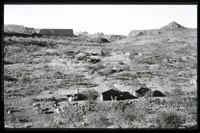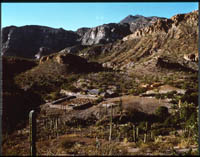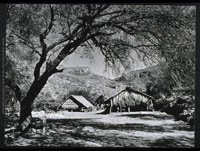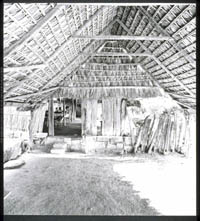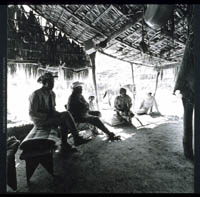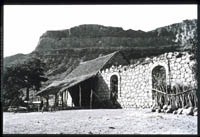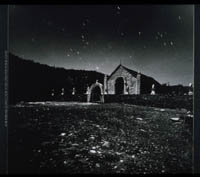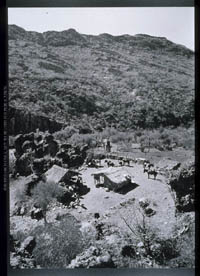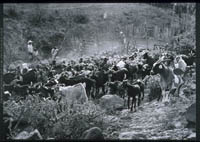| |
Ranch
Types and Ranch Locations
The Baja California
cordillera is made up of a succession of perhaps ten geologic structures,
granite at the northern and southern extremes, sedimentary capped
by volcanics in central regions. The peaks of most are in the range
of 5,000' to 6,500' but San Pedro Martir, in the north, rises over
10,000'. Mountain ranches occupy very diverse and usually picturesque
locations. Some nestle in valleys at the base of a sierra; some occupy
shelves alongside higher arroyos, others sit on intermediate or high
mesas. Few are located above 3,000' because sites were determined
by the availability of permanent water, which is rarely found in the
barren stone of the higher uplands. Ranch economies depend on available
resources. At a few dozen locations, ranchers have been able to create
huertas or orchard gardens large enough to feed their immediate people
and at times provide saleable or tradeable surplusses. Most lowland
ranches depend on cattle for income. At higher elevations, the basis
is goats. The rugged geology makes most ranch sites visually striking.
Because the peninsula is so narrow, many also command views that terminate
with the gulf or the Pacific.
- View
northward over Rancho de San Antonio, 1972
San Antonio and San Francisco, its larger neighbor, occupy different
parts of a broken mesa 3000' in elevation in the Sierra de San Francisco.
- Rancho
de Santa Bárbara on the eastern slope of Sierra de San Juan,
1973.
- Rancho de
Vivelejos, 1980.
Vivelejos long had the distinction of being one the ranches most
remote from any sort of automobile road. Recent construction brought
a road within less than ten miles but the terrain is so rugged,
the remaining gap will probably be bridged on foot or animal back
for a long time.
- Rancho
de San Dionisio in the foothills of the Sierra de la Laguna, 1972.
Baja California's cape region, crossed by the Tropic of Cancer,
extends southward into a meteorological and climatological zone
quite different from those of other parts of the peninsula. A steep
sierra rises to plateaus at 4000'-6000' and peaks over 6500'. The
combination produces particularly heavy summer rains and total rainfall
figures that can be a power of ten greater than the arid mid-peninsula.
Ranches in the foothills are often set in a grove of trees and their
people look out, at least seasonally, on verdure unknown to their
peers in more northerly regions.
|
| |
The
Corredor as an Institution
Every ranch has
a corredor, a covered but open-sided outdoor area where the family
can sit in some comfort even during the hottest weather. The corredor
is also the ranch's meeting place, the salon where guests are seated
and regaled. When I visited, Rancho de la Soledad in the southern
end of the Sierra de la Giganta was the old, permanent home of a prosperous
family; it had nearby orchards and corrals. Rancho de las Calabazas
was a poor goat ranch 3000' feet up in the more remote and rustic
Sierra de San Francisco. Each had a corredor and offered me the remarkable
peninsular hospitality.
- Corredor
at Rancho de la Soledad, 1972
- Corredor
at Rancho de las Calabazas, 1971
|
| |
Ranches
for the Peninsular Gentry
During the latter
part of the 19th century and the first years of the 20th, a few prosperous
Baja Californians, people who lived primarily in towns along the gulf,
acquired attractive rural property always with good water supplies
and often exposed to Pacific breezes. Here they built comfortable
country houses to which they repaired during hot weather or whenever
they felt the need for rest or change. Rancho de la Purificacion and
Rancho de la Soledad are among a dozen or more attractive examples,
some now in ruins, others still in use and good repair.
- Rancho
de la Purificación, 1972
This once-elegant cut stone ranch house was abandoned during the
1920s and subsequently reoccupied by a rancher who made the minimum
repairs and additions needed to house his family.
- Chapel
at Rancho de la Soledad, 1972
When the well-to-do owned ranches, they could add to their prestige
by building private chapels at their country seats. These places
of devotion were intended primarily for family and friends. Masonry
was the medium for construction in all cases. Some chapels were
small, suitable for only a few persons, while others, like this
one built in 1899, were large enough to accommodate neighbors and
employees when a priest was invited to perform a service.
- Las
Jícamas, a seasonal goat ranch, 1980
As the population of the mid-peninsular sierras grew, cattle- the
basis of the economy-occupied all suitable pasturage. Younger sons
turned to goats that could browse off the flora of steeper and higher
parts of the sierras. Many ranches formed in the mid-twentieth century
depended solely on goats. When the lands around those ranches became
overgrazed, another step was taken. Younger families pushed into
areas that had only the seasonal water found in tinajas, natural
catchment basins. They took their herds of goats, milked them, and
made cheese as long as possible, then withdrew to family ranches
with permanent water, usually at lower elevations. The seasonal
ranchers are called cambiaderos, those who move about, and the temporary
homes that they build in the mountains are called cambiadero ranches.
Las Jícamas is an example; its mother ranch is 200 year-old
San Martín.
- Goats
released after milking at Rancho de las Jícamas, 1980
Goats are penned near the ranchhouse at night, partly to keep track
of their whereabouts, partly to protect them from mountain lions.
Milking is done before dawn and the animals are released to find
fodder. The goatherds, usually the family's eight-to-fourteen year-olds,
and a dog round up the animals at the end of the day and return
them to the pen.
|

